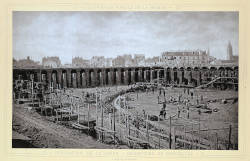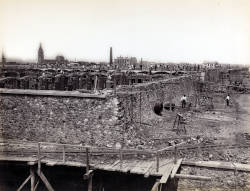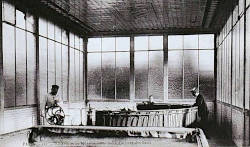Réservoir de Montsouris
Réservoir de la Vanne - Réservoir de Montrouge
Useful Information



| Location: |
Place Jules Hénaffe, 75014 Paris.
(48.824690, 2.333430) |
| Open: |
All year Sat, Sun after appointment. On the European Heritage Days Sat, Sun 8-20. Water Pavilion: All year Mon-Fri 10-18, Sat 11-19. [2023] |
| Fee: |
Water Pavilion:
free. [2023] |
| Classification: |
 Cistern Cistern
|
| Light: |
 Electric Light Electric Light
|
| Dimension: | V=203,000 m³, T=12 °C. L=254 m, W=127 m. |
| Guided tours: | |
| Photography: | not allowed |
| Accessibility: | no |
| Bibliography: |
Marie Françoise Laborde (2003):
Architecture industrielle
Paris & alentours. Parigramme, Paris (France), ISBN-10: 2840963159, pp. 62.

Nicolas Tsoumas (1998): Le réservoir d’eau de Montsouris In: Travaux, n. 746 (October 1998), pp. 34-37. 
|
| Address: |
Réservoir de Montsouris, Place Jules Hénaffe, 75014 Paris.
Eau de Paris, 19 rue de Neuve-Tolbiac, CS 61373, 75214 Paris Cedex 13, Tel: +33-974-506-507. Pavillon de l’eau, 77 avenue de Versailles, Paris 16e, Tél. +33-142-24-54-02. |
| As far as we know this information was accurate when it was published (see years in brackets), but may have changed since then. Please check rates and details directly with the companies in question if you need more recent info. |
|
History
| 1869 | beginning of construction. |
| 1873 | completed. |
| 1874 | Vanne and Loing aqueducts connected. |
| 1875 | water delivered to the Champs-Élysées district. |
| 2010 | managed by the company Eau de Paris. |
Description
The Réservoir de Montsouris (reservoir of Montsouris) is one of the five main water cisterns of the city of Paris. The water in the cistern is collected from various springs and rivers. The water is transported to Paris with the Arcueil and Cachan aqueducts and the Vanne and Loing aqueducts. Today this reservoir supplies the southern and eastern part of the city.
For its construction, a former limestone quarry in the underground of the 14th arrondissement was used. It was built by the engineer Eugène Belgrand (*1810-✝1878) between 1869 and 1873. He was general engineer of Bridges and Roads, known for his participation in the renovation work in Paris led by Baron Haussmann. He also designed the major spring water supply project, the development of the Paris sewer network and the creation of a dual network of drinking and non-drinking water. Non-potable water, also called raw water, is mostly used by the municipal services to fill lakes and rivers, water green spaces, wash sidewalks and roads, and clean the sewers. The work on this reservoir was supervised by Octave Keller, the later General Inspector of Seine quarries. At that time the people were still drinking the water of the Seine, which had become too polluted to be safe to use for human consumption.
Originally, the water came directly from the sources, from rivers, and it seems there was even rain water added to the reservoir. Until 1996, trout were kept in aquariums. The water was flowing through those aquariums before entering the reservoir. Trout are very sensitive to pollution, and so they were used like a canary in a coal mine, to detect impurities in the water. Since 1996 the tests are done by lab analysis, which is less elegant, but probably safer. Since the early 2000s, all water is treated in the L’Haÿ-les-Roses plant before being stored in Montsouris, to comply with European standards. The first spring which was used in 1874 was the Vanne spring, and so the reservoir was first called Réservoir de la Vanne, a name which can be found on various places in the historic structure.
The rectangular cistern consists of four compartments each 254 m long and 127 m wide on two levels. The two lower compartments are 7 m high and can contain 63,000 m³ of water each. The two upper compartments are 4 m high and can contain 38,500 m³ each. This makes a total of 203,000 m³ in the reservoir. Each compartment has its own inlet and outlet pipe, so it is possible to close one compartment for renovation or cleaning while maintaining continuity of service. A total of 1,800 masonry pillars are supporting numerous vaults and arcades.
The site is normally closed to the public, but tours are offered by the company Eau de Paris, which operates the site, for groups after appointment. The site is also open for individuals and certain days of the year, e.g. the European Heritage Days in September. The dates are not really announced much in advance, if you are interested, contact the City of Paris or the company Eau de Paris. The Entrance is through the building at Place Jules Hénaffe, on the southwestern corner. The company Eau de Paris, formerly called Société Anonyme de Gestion des Eaux de Paris (SAGEP), has brochures on their website. They also have a small museum called Pavillon de l’eau (Water Pavilion), which is open on weekdays.
- See also
 Search DuckDuckGo for "Réservoir de Montsouris"
Search DuckDuckGo for "Réservoir de Montsouris" Google Earth Placemark
Google Earth Placemark OpenStreetMap
OpenStreetMap Réservoir de Montsouris
Réservoir de Montsouris  - Wikipedia (visited: 01-DEC-2023)
- Wikipedia (visited: 01-DEC-2023) Le réservoir de Montsouris, un joyau architectural
Le réservoir de Montsouris, un joyau architectural  (visited: 01-DEC-2023)
(visited: 01-DEC-2023) À la découverte du trésor caché du réservoir Montsouris
À la découverte du trésor caché du réservoir Montsouris  (visited: 01-DEC-2023)
(visited: 01-DEC-2023) Montsouris Stausee
Montsouris Stausee  (visited: 01-DEC-2023)
(visited: 01-DEC-2023)
 Index
Index Topics
Topics Hierarchical
Hierarchical Countries
Countries Maps
Maps